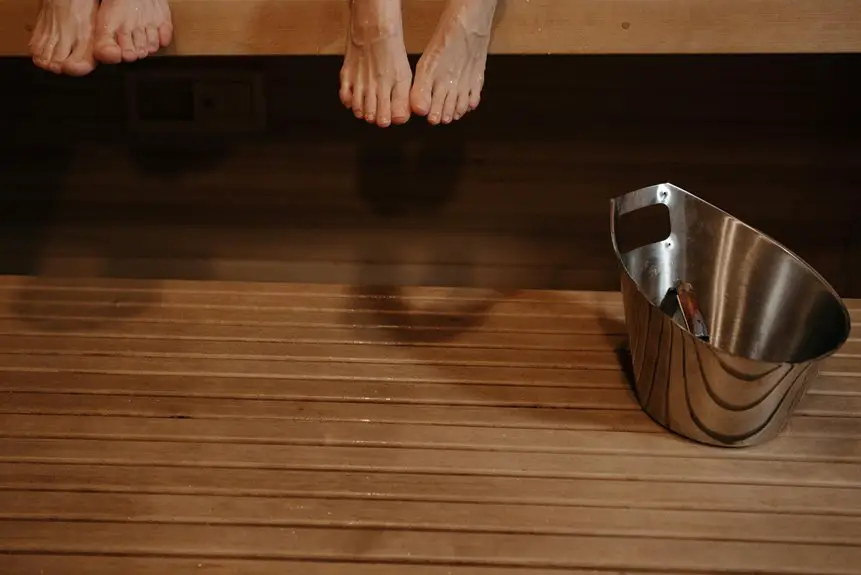You might notice some foot sweat when wearing Gore-Tex shoes because while they block outside water, they only let your feet’s moisture escape so much. Gore-Tex membranes balance waterproofing with breathability but can’t fully prevent sweat buildup, especially during intense activity or in hot conditions. Choosing proper moisture-wicking socks and caring for your footwear can help manage sweat. Want to understand how Gore-Tex works and find tips for staying comfortable? There’s more to discover ahead.
Table of Contents
Key Takeaways
- Gore-Tex membranes block external water but allow sweat vapor to escape, reducing but not eliminating foot sweat buildup.
- Foot sweat depends on activity level, temperature, humidity, and duration of wear, not just Gore-Tex material.
- Gore-Tex boots paired with moisture-wicking socks help manage sweat better than cotton socks.
- Excessive sweating may occur during intense activities, as no waterproof fabric is 100% breathable.
- Proper shoe drying, ventilation, and sock choice improve comfort and reduce moisture inside Gore-Tex footwear.
How Gore-Tex Technology Works
Gore-Tex technology uses a special membrane with microscopic pores that block water droplets but let sweat vapor escape.
When you wear Gore-Tex footwear, this membrane acts as a barrier, keeping rain and puddles out while allowing moisture from your feet to pass through. You won’t feel soaked from outside water, but sweat won’t build up inside either.
The key is the size of these pores—they’re about 20,000 times smaller than a water droplet but 700 times larger than a sweat vapor molecule. This difference means water can’t penetrate your shoes, but vapor can move outward.
As you move, your body generates sweat, and Gore-Tex helps regulate that moisture, contributing to your overall comfort during outdoor activities.
The Breathability Factor in Waterproof Gear
You want your waterproof gear to keep water out but still let sweat escape, right?
That’s where moisture vapor transmission comes in—it’s the key to balancing waterproofing with breathability.
Understanding how heat and sweat management work can help you stay comfortable no matter the conditions.
Moisture Vapor Transmission
Moisture vapor transmission plays an essential role in keeping your feet dry and comfortable inside waterproof gear. It allows sweat in the form of vapor to escape while blocking water from entering. This process helps regulate temperature and prevents your feet from feeling clammy or overheated.
Here’s what you should know about moisture vapor transmission:
- Gore-Tex membranes have microscopic pores that let vapor out but keep liquid water out.
- Efficient vapor transmission reduces sweat buildup inside your boots.
- It works best when paired with moisture-wicking socks.
- High moisture vapor transmission ratings indicate better breathability.
- You might still sweat if your activity level is intense or the environment is hot.
Understanding this helps you choose gear that balances protection and comfort.
Waterproof vs. Breathable
Although keeping water out is essential, ensuring your gear lets sweat escape is just as important for comfort.
When you’re choosing waterproof footwear like Gore-Tex shoes, you want a balance between blocking external moisture and allowing internal moisture vapor to pass through. If the material isn’t breathable enough, sweat can accumulate inside, making your feet feel clammy despite dryness from rain.
Gore-Tex uses microscopic pores that are small enough to repel water droplets but large enough to let sweat vapor out. This design helps prevent that soggy, uncomfortable feeling.
However, no waterproof fabric is 100% breathable, so you might still notice some moisture buildup during intense activity. Understanding this balance helps you pick gear that keeps your feet dry without trapping sweat inside.
Heat and Sweat Management
Three key factors determine how well waterproof gear manages heat and sweat: material breathability, ventilation design, and activity level.
When you wear Gore-Tex footwear, its breathability helps moisture escape, but your body’s heat and sweat production still play a big role. Proper ventilation, like mesh panels or adjustable vents, can boost airflow and keep your feet drier.
Also, the intensity of your activity influences how much you sweat inside your boots, so choosing footwear suited for your pace is essential.
Consider these points for better heat and sweat management:
- Gore-Tex’s microporous membrane breathes but blocks water
- Ventilation features enhance airflow
- High-intensity activities increase sweat output
- Moisture-wicking socks reduce dampness
- Proper boot fit prevents excess heat buildup
Understanding these helps you stay comfortable and dry.
Why Feet Sweat Inside Gore-Tex Footwear
Sweat inside Gore-Tex footwear happens because your feet naturally produce moisture that the membrane can’t always release quickly enough.
Gore-Tex is designed to be waterproof yet breathable, allowing water vapor to escape while blocking liquid water. However, when your feet generate sweat faster than the membrane’s breathability rate, moisture builds up inside.
This is especially common if your feet stay warm and active. The membrane’s microscopic pores let vapor out but don’t vent liquid sweat directly, so excess moisture can accumulate.
Additionally, the inner lining and sock materials can trap some moisture against your skin. Understanding this helps you realize that sweating isn’t caused by Gore-Tex itself but by the natural limits of moisture management in enclosed footwear.
The Role of Activity Level and Environment
Your level of activity and the environment you’re in greatly affect how much your feet sweat inside Gore-Tex footwear.
Activity level and environmental conditions significantly impact foot sweat inside Gore-Tex shoes.
When you move vigorously, your body generates more heat and sweat, which your feet need to release. Gore-Tex membranes allow moisture to escape but can only keep up to a point.
Environmental factors like temperature, humidity, and terrain also influence sweat levels and comfort.
Consider these factors:
- Intensity of your physical activity
- Ambient temperature during use
- Humidity levels in your surroundings
- Terrain type (e.g., rocky, wet, dry)
- Duration of continuous wear
Comparing Gore-Tex to Other Waterproof Materials
While Gore-Tex has become a popular choice for waterproof footwear, you might wonder how it stacks up against other materials designed to keep your feet dry.
Compared to rubber or PVC boots, Gore-Tex offers superior breathability, allowing moisture from sweat to escape while blocking external water. This balance helps reduce clamminess inside your shoes.
On the other hand, materials like eVent or SympaTex also provide waterproof protection with varying breathability levels, sometimes rivaling Gore-Tex. However, Gore-Tex’s extensive testing and durability often give it an edge in reliability.
If you prioritize both dryness and comfort during intense activities, Gore-Tex generally outperforms traditional waterproof materials but keep in mind that no material is entirely sweat-proof.
Tips to Reduce Foot Sweat in Gore-Tex Shoes
To keep your feet drier in Gore-Tex shoes, start by choosing breathable socks that help wick moisture away.
Adding moisture-wicking insoles can also reduce sweat buildup inside the shoe.
Finally, make sure you let your shoes dry fully between wears to prevent trapped moisture.
Choose Breathable Socks
Anyone aiming to reduce foot sweat in Gore-Tex shoes should start by choosing breathable socks.
The right socks help improve airflow, wick moisture away, and keep your feet drier throughout the day. Avoid cotton socks since they trap moisture, making your feet sweat more. Instead, look for socks made from materials designed to enhance breathability and comfort.
Here are five tips for choosing breathable socks:
- Opt for synthetic fibers like polyester or nylon blends.
- Consider merino wool socks for natural moisture control.
- Choose socks with mesh panels or ventilation zones.
- Select socks with a snug but not tight fit to avoid restricting airflow.
- Replace worn-out socks regularly to maintain breathability.
Use Moisture-Wicking Insoles
Although Gore-Tex shoes offer great waterproofing, they can still trap moisture inside, making moisture-wicking insoles essential for reducing foot sweat.
You should choose insoles made from materials like activated charcoal, bamboo fiber, or specialized moisture-wicking foam, which draw sweat away from your skin and keep your feet dry.
These insoles also help improve airflow inside your shoes, limiting the dampness that encourages bacteria and odor.
Replace your insoles regularly to maintain their effectiveness, especially if you wear your Gore-Tex shoes often.
Using moisture-wicking insoles in combination with breathable socks creates a powerful defense against sweaty feet, ensuring more comfort and less risk of blisters or fungal infections.
Don’t underestimate the impact of quality insoles on your overall foot health when using Gore-Tex footwear.
Allow Shoes to Dry
Moisture-wicking insoles help manage sweat inside your Gore-Tex shoes, but they can only do so much if your shoes stay damp after use. To keep your feet dry and comfortable, you need to allow your shoes to dry thoroughly between wears.
Proper drying prevents odor and bacterial buildup, reducing sweat-related issues.
Here’s how you can effectively dry your Gore-Tex shoes:
- Remove insoles and loosen laces to improve airflow
- Place shoes in a well-ventilated area away from direct heat
- Stuff shoes with newspaper to absorb moisture quickly
- Use a fan to speed up the drying process
- Avoid using a dryer or direct sunlight to prevent material damage
Best Socks to Wear With Gore-Tex Footwear
Choosing the right socks plays an essential role in maximizing comfort and breathability when wearing Gore-Tex footwear. You want socks that wick moisture away from your skin to keep your feet dry and prevent sweating inside the waterproof layers.
Look for socks made of merino wool or synthetic blends designed for moisture management. Avoid cotton, as it retains moisture and can make your feet feel damp and uncomfortable. Choose socks with a snug fit to reduce friction and prevent blisters.
Additionally, socks with extra cushioning in key areas can improve comfort during long walks or hikes. By pairing Gore-Tex shoes with moisture-wicking, breathable socks, you’ll enhance airflow and reduce sweat buildup, keeping your feet comfortable and dry throughout the day.
Maintenance and Care for Gore-Tex Footwear
To keep your Gore-Tex footwear performing well, you need to clean and maintain them regularly. Dirt and grime can clog the membrane, reducing breathability and waterproofing.
Follow these key steps to extend your shoes’ lifespan and keep your feet comfortable:
- Remove dirt with a soft brush or cloth after each use
- Hand wash with mild soap and lukewarm water; avoid harsh detergents
- Let them air dry away from direct heat or sunlight
- Apply a suitable water-repellent spray to refresh the outer layer
- Store in a cool, dry place to prevent mold and material breakdown
When to Consider Alternative Footwear Options
Even with proper care, Gore-Tex footwear mightn’t always meet your needs, especially if your feet sweat excessively or you face specific activity demands.
If you notice persistent moisture buildup or discomfort despite using Gore-Tex, it’s time to explore alternatives. For high-intensity activities like running or trail running, breathable mesh shoes without waterproof membranes may keep your feet drier.
In hot climates, lightweight sandals or ventilated shoes can improve airflow and reduce sweat. If you experience skin irritation or fungal infections, switching to moisture-wicking socks paired with more breathable footwear helps.
Also, consider shoes with removable insoles for easy drying. Listening to your feet’s signals and adapting your footwear guarantees comfort and prevents issues linked to excessive sweating in Gore-Tex shoes.
Frequently Asked Questions
Can Gore-Tex Be Recycled or Is It Environmentally Friendly?
You’d love Gore-Tex’s eco-friendliness, right? Well, it’s tricky—Gore-Tex isn’t easily recyclable, and its environmental impact isn’t exactly green. So, don’t expect a guilt-free footprint when rocking those waterproof boots.
Are Gore-Tex Shoes Suitable for Diabetic Foot Care?
You can consider Gore-Tex shoes for diabetic foot care because they offer waterproof protection and breathability. However, always prioritize proper fit and consult your healthcare provider to guarantee they meet your specific medical needs and prevent complications.
How Long Does Gore-Tex Waterproofing Typically Last?
You’ll think Gore-Tex’s waterproofing lasts forever, but it typically lasts about 1-2 years with regular use. You’ll need to reapply a durable water repellent treatment to keep your gear performing like new.
Is Gore-Tex Effective in Extreme Cold Weather Conditions?
Gore-Tex works well in extreme cold by keeping moisture out while letting sweat escape, so you stay dry. However, you’ll want proper insulation layers since Gore-Tex alone doesn’t provide warmth in freezing temperatures.
Can Gore-Tex Materials Cause Allergic Skin Reactions?
Imagine your skin throwing a tiny tantrum—Gore-Tex rarely causes allergic reactions since it’s designed to be gentle. But if you’re sensitive to certain chemicals, you might feel irritation. Always test before long wear.
- Does Chiffon Fabric Stink - July 15, 2025
- Does Chiffon Fabric Affect the Economy - July 15, 2025
- Does Cotton Fabric Have a Nap - July 15, 2025



![Best Moisture-Wicking Socks for [Running/Hiking/Everyday]: Stop Sweaty Feet sweat free foot comfort](https://knowingfabric.com/wp-content/uploads/2025/06/sweat_free_foot_comfort_a2jxe-150x150.jpg)



